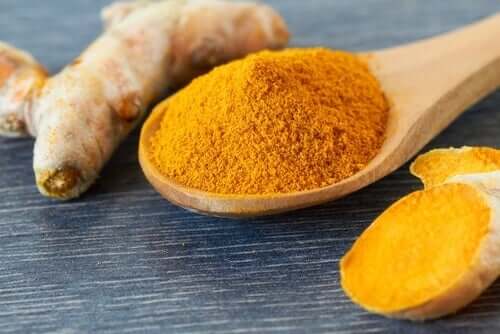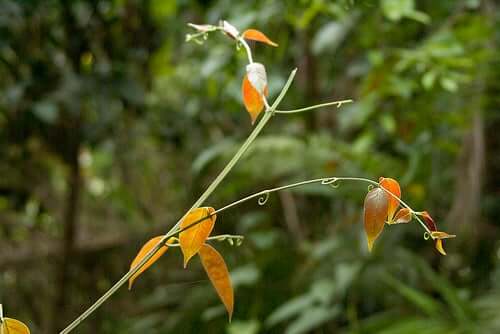3 Medicinal Plants to Treat Tennis Elbow

Tennis elbow is a condition that occurs when the tendons in the elbow are affected. The main cause of this problem is repetitive wrist and arm movements. To treat tennis elbow, specialists usually prescribe drugs that relieve inflammation and pain.
On the other hand, in serious cases, the patient may need surgery. However, there are some alternatives with medicinal plants that can help treat this condition. In this article, we share 3 remedies with medicinal plants that could effectively and significantly reduce discomfort.
What is tennis elbow?
Although more common in athletes, tennis elbow or epicondylitis is actually an injury that can affect anyone who makes certain constant movements of the forearm and wrist. For example, it can affect people who work in painting, construction, butchering, etc.
This condition causes pain on the outside of the elbow, which is known as epicondyle. In terms of symptoms, a Mayo Clinic publication suggests that pain and loss of strength may make the following tasks difficult:
- Shaking hands or holding an object
- Turning a doorknob
- Holding a cup of coffee
Also read: 5 Exercises that Won’t Affect your Joints
Medicinal plants to treat tennis elbow
As we said, some medicinal plants may help treat tennis elbow naturally. However, it’s best to take them under medical supervision, as some may have contraindications or be incompatible with some medications.
1. Turmeric

The first option is turmeric, an ancestral natural remedy that’s increasingly recommended in alternative medicine for different conditions that cause pain and inflammation. In addition, it’s highly recommended due to the properties of its active ingredient, curcumin, which also has antioxidant effects.
In this regard, a review published in the magazine Foods found that this component is effective in treating inflammation and muscle pain caused by exercise. Therefore, it would improve recovery and subsequent performance in active people.
Turmeric can be eaten as a spice in any kind of recipe, both sweet and savory. It also works very well as a natural coloring. One of the most popular preparations in recent years is golden milk.
The basic ingredients are milk (cow or vegetable) and turmeric. However, other spices such as cinnamon, cardamom, ginger, cumin, etc. can also be added. Follow the steps described below and enjoy the benefits.
Ingredients
- 2 cups of milk of your choice (250 ml)
- 1 teaspoon of turmeric powder (0.3 oz/10 gr)
- 1/2 teaspoon of powdered cinnamon (0.2 oz/5 gr)
- Honey (optional)
2. Ginger
In second place, there’s another spice from the same turmeric family: ginger. The rhizome of this plant stands out as a natural anti-inflammatory. In fact, according to a study in The Journal of Pain, consuming 2 grams of ginger per day for 11 days reduced muscle pain in people who did elbow exercises.
To make the most of its effects, you can combine the consumption of fresh ginger (in juice or infusion), with the topical application of its essential oil. Don’t forget that the latter must be diluted in another base oil such as olive, coconut or almond. Keep reading to learn how to prepare a ginger infusion.
Ingredients
- 1 cup of water (250 ml)
- 2 small slices of ginger
- Honey (optional)
Preparation
- Heat the cup of water over medium heat.
- When it starts boiling, add the ginger slices and turn off the stove top.
- Let it rest for 10 minutes and serve it.
- You can sweeten it with honey if you want.
Discover: 8 Benefits of Eating Honey Daily
3. Cat’s claw

Cat’s Claw is the name given to the Uncaria tomentosa plant, native to the Amazon region. This plant is known for its health benefits, namely its anti-inflammatory and anti-tumor benefits.
Although there’s no scientific evidence regarding its effects on tennis elbow, a review published in Complementary Therapies in Clinical Practice states that consuming it contributed to reducing inflammation and relieving pain in people with rheumatoid arthritis.
As for how to consume it, the best way to take cat’s claw is as a supplement. This way, it’s easier to control the dose, since, although adverse effects aren’t very common, the high levels of tannins of the plant could cause nausea, stomach pain and diarrhea.
Now that you know the benefits of these medicinal plants to treat tennis elbow naturally, don’t hesitate to include them in your daily routine if you suffer from this condition. If you use them regularly, you’ll probably notice an improvement in pain and inflammation.
However, remember that personalized medical diagnosis and treatment shouldn’t be neglected. For this reason, if the pain doesn’t subside or you have other related symptoms, then it’s best to go to a professional.
All cited sources were thoroughly reviewed by our team to ensure their quality, reliability, currency, and validity. The bibliography of this article was considered reliable and of academic or scientific accuracy.
- Insights, C. N. (1999). Understanding The Natural Management of Pain and Inflammation. Clinical Nutrition Insights.
- Curcuma longa (turmeric). Monograph. (2001). Alternative Medicine Review : A Journal of Clinical Therapeutic.
- Sandoval-Chacón, M., Thompson, J. H., Zhang, X. J., Liu, X., Mannick, E. E., Sadowska-Krowicka, H., … Miller, M. J. S. (1998). Antiinflammatory actions of cat’s claw: The role of NF-κB. Alimentary Pharmacology and Therapeutics. https://doi.org/10.1046/j.1365-2036.1998.00424.x
- Srinivasan, K. (2017). Ginger rhizomes (Zingiber officinale): A spice with multiple health beneficial potentials. PharmaNutrition. https://doi.org/10.1016/j.phanu.2017.01.001
-
Hardin SR. Cat’s claw: an Amazonian vine decreases inflammation in osteoarthritis. Complement Ther Clin Pract. 2007;13(1):25-28. doi:10.1016/j.ctcp.2006.10.003
-
MDPI and ACS Style. Hewlings, S.J.; Kalman, D.S. Curcumin: A Review of Its’ Effects on Human Health. Foods 2017, 6, 92. https://doi.org/10.3390/foods6100092
- Clínica Mayo. Codo de tenista. (2019). Recuperado el 31 de agosto de 2020. https://www.mayoclinic.org/es-es/diseases-conditions/tennis-elbow/symptoms-causes/syc-20351987
This text is provided for informational purposes only and does not replace consultation with a professional. If in doubt, consult your specialist.








